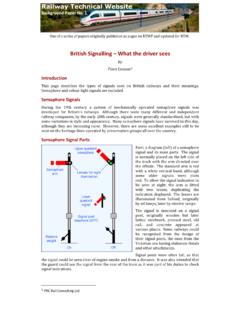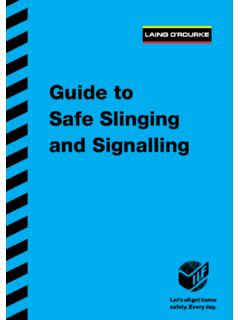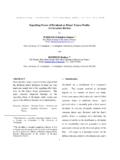Transcription of IDELINE ON Y OF SIGNALLING AND …
1 GL INSLOSSTESTITUTIOMSARELECT ON OF RMINOR RGURY OFCOMTERM RAILWAYRAILWAYUIDELINF SIGMMUMINOY SIGNAYS SECTNE ON GNANICAOLORef NIssue Issue AL ENGINTION ALLIATIOGY No: Glo No: date: JanNEERS NG AONS ossary 0 nuary 2011 AND D Institution of Railway Signal Engineers Minor Railways Section Guideline on Ref: Glossary Issue Glossary of SIGNALLING and Telecommunications Terminology January 2011 Page 2 of 39 IRSE 2011 Uncontrolled when Printed Record of Amendments Issue Date Amendments 15/01/11 Original issue Anyone who wishes to contribute additional items; or correct / amend any of the entries; or wants further information may contact the IRSE Minor Railways Section Document Co-ordinator at or via the IRSE Headquarters.
2 Institution of Railway Signal Engineers Minor Railways Section Guideline on Ref: Glossary Issue Glossary of SIGNALLING and Telecommunications Terminology January 2011 Page 3 of 39 IRSE 2011 Uncontrolled when Printed INTRODUCTION This document defines the meaning of commonly used SIGNALLING and telecommunications terms to ensure that each term is clearly understood and always used to convey the same meaning. This section includes terms in common use within railway SIGNALLING or Telecommunications engineering, together with related railway operating and infrastructure terms.
3 It is understood that this document cannot be all encompassing for all regions but relates only to Signal and Telecommunications Engineering. The Operations Department may have different understanding of the terms. It also supplements other guidelines issued by the IRSE Minor Railway section. The glossary is arranged in alphabetical order, with each entry shown in bold type. A word or group of words in italic type refers to another entry providing further information. Some entries simply cross-refer to other entries. These may be abbreviations or terms referring to the full or more commonly used entry.
4 Generally, the full definition is only given once. The following have not been included; a) Terms specific to the internal component parts of electronic systems or subunits, for example, CPU, MPM, PPM. These are generic to many system types b) Specific terms relating to specialised activities such as signal sighting. Signal Names. The use of signal names such as Home Signal and Starting Signal refer to current accepted practice. Historically there have been regional variations of signal names, particularly for Home Signal, Inner Home Signal and Outer Home Signal.
5 Some of these variations are shown but it is not a complete list. Anyone who wishes to contribute additional items or correct / amend any of the entries or want any further information on this subject please contact the IRSE Minor Railways Section Document Co-ordinator at or via the IRSE Headquarters. Institution of Railway Signal Engineers Minor Railways Section Guideline on Ref: Glossary Issue Glossary of SIGNALLING and Telecommunications Terminology January 2011 Page 4 of 39 IRSE 2011 Uncontrolled when Printed TERM DEFINITION ABSENCE SWITCH A switch which, when operated, allows a SIGNAL BOX to be unmanned for a period by restricting the operation of some equipment, such as alarms.
6 ABSOLUTE BLOCK A system of controlling trains, where (under normal operations) only one train is allowed into a BLOCK SECTION at a time. Proof of a section clear normally involves the observation of the train TAIL LAMP by the SIGNALMAN. ABSOLUTE POSSESSION See POSSESSION. AC Alternating Current ACCEPTANCE A block SIGNALLING term where a train is permitted to proceed towards the accepting signal box. The block regulations provide for circumstances under which a signalman may accept a train. ACCEPTANCE LEVER See direction lever. ACCOMMODATION LEVEL CROSSING A private vehicular LEVEL CROSSING connecting land in the same ownership separated by a railway line.
7 ADVANCED STARTING SIGNAL In Block SIGNALLING , a Stop Signal beyond the Starting Signal, and worked from the same Signal Box. An alternative term for Section Signal on the Western Region. ADVANCED WARNING BOARD (AWB) A sign incorporating a St. George s Cross provided on the APPROACH TO certain open LEVEL CROSSINGs to inform the driver to regulate the speed of the train in order to observe the restriction of speed which applies over the crossing. ADVANCE WARNING INDICATOR (AWI) A sign provided on the approach to a permanent or temporary speed restriction board.
8 ALIGHT The internal illumination of SIGNALLING equipment. ALPHANUMERIC ROUTE INDICATOR A Route Indicator that conveys its information by illuminated alphanumeric characters. Designated standard and miniature as a reference to size and readability. ANNETT S KEY/LOCK A locking mechanism, often for unlocking a ground frame or other equipment. The key may be held captive in an instrument or lock which can be released from the controlling signal box. ANNUNCIATOR An audible indicator, bell or buzzer. ANTI-PRESELECTION The prevention of preselecting a SIGNALLING function before the interlocking allows the function to be used.
9 APPARATUS CASE (OR CUPBOARD) A housing containing equipment which is normally intended for outdoor use. APPROACH CONTROL The restriction of the ASPECT of a SIGNAL to ensure that the driver can comply with the TURNOUT SPEED or to control the speed of the train for a SUBSIDIARY or SHUNTING SIGNAL. Institution of Railway Signal Engineers Minor Railways Section Guideline on Ref: Glossary Issue Glossary of SIGNALLING and Telecommunications Terminology January 2011 Page 5 of 39 IRSE 2011 Uncontrolled when Printed TERM DEFINITION APPROACH LOCKING The locking of any POINTS or a ROUTE from a SIGNAL, when the driver has seen or may have seen a PROCEED ASPECT at the signal.
10 If the signal is replaced to danger, the approach locking prevents the release of the route or points because it is possible that the approaching train may be unable to stop. APPROACH RELEASE An alternative term for APPROACH CONTROL. APPROACH TO An alternative term relating to IN REAR OF. APPROACH LIGHTING The lighting or illumination of a SIGNAL only on the approach of a train. If no train is approaching, no light is displayed. AREA OF CONFLICT A section of line BEYOND the SIGNAL at DANGER on which a head-on, crossing or same direction converging collision with another legitimately positioned train could occur in the event of a SPAD.









